Auckland, Durham
Up to 1834
A parliamentary report of 1777 recorded a parish workhouse in operation in Bishop Auckland for up to 150 inmates. The establishment stood at the south end of Newgate Street, and generally contained from thirty to forty paupers.
After 1834
Auckland Poor Law Union formally came into existence on 9th January 1837. Its operation was overseen by an elected Board of Guardians, 40 in number, representing its 33 constituent townships and parishes as listed below (figures in brackets indicate numbers of Guardians if more than one):
Durham: Auckland St Andrew, Auckland St Helen, Bishop Auckland (4), West Auckland (3), North Bedburn, South Bedburn, Binchester, Bolam, Byer's Green, Counden, Counden Grange, Crook and Billy Row, Eldon, Escombe, Evenwood (2), Hamsterley, Hanwick and Helmington, Helmington, Lynesack and Softly, Merrington, Middlestone, Midridge, Midridge Grange, Newfield, Newton Cap, Old Park, Pollard's Lands, Shildon (2), Thickley, Westerton, Whitworth, Windlestone, Witton-le-Wear.
The population falling within the Union at the 1831 census had been 14,632 with parishes ranging in size from Newfield (population 8) to Bishop Auckland (3,090). The average annual poor-rate expenditure for the period 1834-6 had been £4,574 or 6s.3d. per head of the population.
The first Auckland Union workhouse was the former parish workhouse on Newgate Street, Bishop Auckland. In 1853, the Board of Guardians decided to erect a new workhouse and advertised for plans and specifications for a building to accommodate 100 inmates and costing around £2,000. The new workhouse, situated at the west side of Cockton Hill, opened in 1855 by which time the cost had amounted to almost £5,000 including the purchase of 1.5 acres of land. By 1863, overcrowding necessitated the building of an extension which was opened in 1865.
The site layout is shown on the 1896 map below:
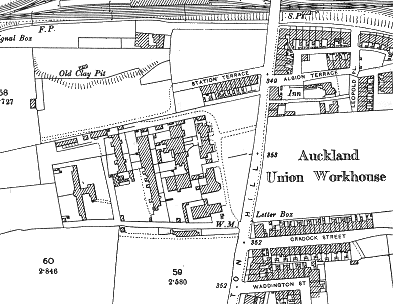
Auckland workhouse site, 1896.
Further extensions costing £6,000 took place in 1877-8 which included a 70-bed infirmary at the west of the site, mortuary.
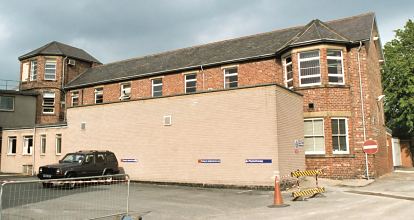
Auckland 1877 infirmary from the south-west, 2001.
© Peter Higginbotham.
At the same time, casual wards, board-room and offices were erected at the south-east corner of the site.
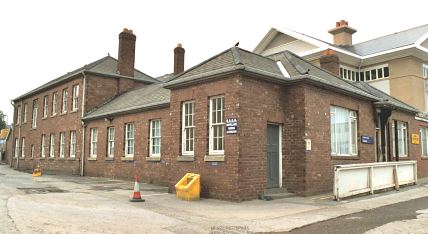
Auckland casual ward block from the east, 2001.
© Peter Higginbotham.
In 1894, the British Medical Journal set up a "commission" to investigate conditions in provincial workhouses and their infirmaries. Following a visit to Bishop Auckland, the commission's report praised "the humanity and care evident in the management of the house." It noted that the infirmary wards were adorned with pictures, plants and flowers; there were strips of matting in the centre, and newspapers were provided for the inmates. In one ward, four old women, one with hemiplegia, another blind, one old age, and the fourth with heart disease, all formed a happy family and were allowed them to set out their treasures and hang up their pictures in the room. The report was not entirely with suggestions for improvement, however: the employment of additional nursing staff was recommended, together with alterations in the accommodation for infectious cases. Further details are available in the full report.
Further expansion in 1909-11 included a new infirmary to the west of the 1877 one.
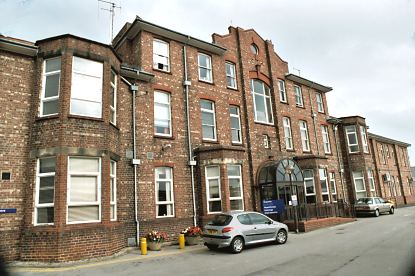
Auckland 1909 infirmary from the south-west, 2001.
© Peter Higginbotham.
In September, 1895, the Poor Law Officers' Journal newspaper reported:
The workhouse later became Oaklands Poor Law Institution. During the First World War it provided beds for sick and wounded military personnel. This happened again during World War 2, and in 1942 the hospital was renamed the Bishop Auckland Emergency Hospital. From 1944 to 1947 it accommodated German prisoners of war.
In 1948, the hospital became Bishop Auckland General Hospital. Later building developments have resulted in the demolition of most of the former workhouse buildings.
Cottage Homes
In 1903, two buildings containing four cottage homes for pauper children were erected on Escomb Road to the north-west of the workhouse site. The construction of the homes cost of £6,000 plus furniture. Four foster mothers were appointed to run the homes which had a total capacity of 60 places. The field around the homes was used as a playground.
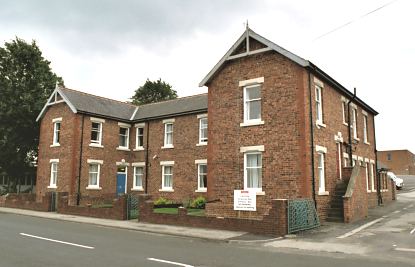
Auckland cottage homes from the north, 2001.
© Peter Higginbotham.
Staff
Inmates
Records
Note: many repositories impose a closure period of up to 100 years for records identifying individuals. Before travelling a long distance, always check that the records you want to consult will be available.
- Durham County Record Office, County Hall, Durham DH1 5UL. Relatively few records survive. Holdings include: Guardians' minutes (1863-6, 1889-1930); Register of apprentices (1875-97); etc.
Bibliography
- The Not-So-Dreaded Auckland Union Workhouse by Di Mellor and Bev Taylor, (2017)
- A History of Medicine in South-West Durham by AJ Ferguson (1989).
- Bishop Auckland Poor Law Union, 1863-6 by D Rose (1970, Durham County Local History Society Bulletin, 13, 2-7.)
Links
Unless otherwise indicated, this page () is copyright Peter Higginbotham. Contents may not be reproduced without permission.


